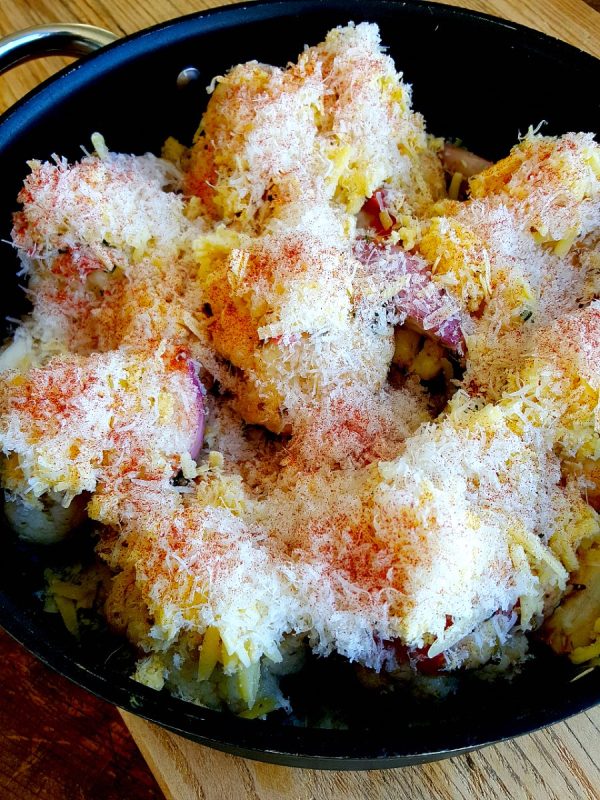Roasted Cauliflower & Shallots with Double Cheese Crust

Introduction
Serves: 4-6
Ingredients
2 bay leaves
Salt
2 Tbsp extra virgin olive oil
1 large tomato, chopped
1 Tbsp capers, roughly chopped
1 Tbsp fresh marjoram or ½ Tbsp dried oregano
Freshly ground black pepper
Flaky sea salt
200g (7 oz) shallots, peeled and cut into slimish wedges
2 Tbsp softened butter
¼ cup panko crumbs
1 cup grated tasty cheddar
½ cup freshly grated parmesan
Smoked paprika, for sieving
Method
1 Remove leaves from cauliflower and trim the stem (reserve any whole small leaves). Bring a large saucepan of water to the boil (choose one that’s big enough to immerse the whole cauliflower in water), add bay leaves and a few pinches of salt, then add the cauliflower, stem down. Leave cauliflower in the water for 4 minutes (regardless of whether the water boils), adding any reserved leaves to the water for the last minute if you want to serve them as an edible garnish. Drain cauliflower and refresh with plenty of cold water, then leave to drain in a colander, stem facing down, until dry.
2 Preheat oven to 200°C (400°F). Mix oil, tomato, capers and marjoram or oregano in a large bowl with black pepper to taste and a few pinches of flaky sea salt. Cut cauliflower into large clumps, add to bowl and toss until coated with dressing. Transfer to a shallow roasting dish. Toss shallots in bowl with remaining dressing and distribute around cauliflower.
3 Gently melt butter and mix with panko crumbs and a little salt and pepper. Put crumble on top of cauliflower, then smother with cheddar cheese and parmesan. Dust with smoked paprika. Bake for 30-35 minutes, until shallots are tender, and everything is crusty and golden.
4 Serve hot or hottish, garnished with blanched cauliflower leaves if using.
Recipe Notes
The aim is to get a good cheesy crust on the top and bottom of the cauliflower and for the shallots to caramelise, but you don’t want the bottom to get too dark and burn. It is easier to keep an eye on progress if you cook the cauliflower in a stainless steel dish, rather than a black or dark-coloured one. Alternatively, line the dish with baking (parchment) paper.
Keep the cauliflower in large clumps, and choose a cooking dish that allows space around each clump of cauliflower so that the cauliflower browns and doesn’t steam.
Can you use red onions in place of shallots? Yes. The colour won’t be as nice – they tend to go dark purpley black in colour, instead of the lovely deep caramel colour of caramelised shallot. White onions? Yes, peel, cut through root to help hold together. They take longer to cook though so you may need to leave them in the dish and return them to the oven for further cooking once the cauliflower is ready (transfer cauliflower to a platter).





